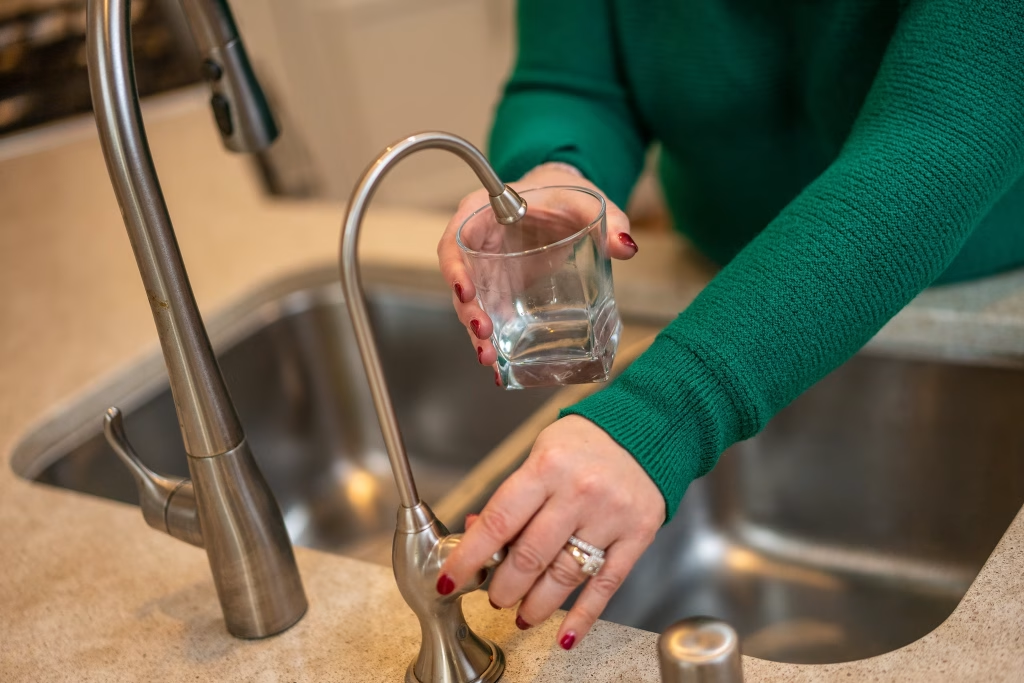Different Drinking Water System Choices
The choice of a drinking water system is probably the most important in designing a water treatment system. From the amount of contaminants your system removes to a lower total cost of ownership, Water Doctors offers both reverse osmosis and activated carbon solutions to improve your drinking water quality.
Reverse Osmosis w/ Carbon Combination
Reverse osmosis is a membrane-based system. The membrane has very tiny pores and works by blocking anything larger than a water molecule from getting through. The system is only as effective as the membrane, so a lower-grade membrane will produce lower-quality water and require more frequent replacement. This drives up the total cost of ownership.
Third parties measure reverse osmosis system performance and compile results into datasheets listing contaminants reduced or removed. The better the system, the longer the datasheet. Some lower-end systems may only be tested to reduce 50–80% of what is in the water. The Kinetico® K5 Drinking Water Station® has one of the most extensive datasheets in the industry.
Carbon Block or Activated Carbon Only
Carbon covers a wide range of filters. The lower end, typically a loose, granulated carbon, includes most of the pitcher-types and refrigerator filters. Higher grade filters feature a denser block of carbon and are more effective than granulated carbon. The Always Fresh filters that we carry are a dense carbon block, affording high levels of chlorine reduction. The density increases the contact time water has with the filter, removing more volatile organic chemicals like herbicides and pesticides.
The Always Fresh filter also has a silver-based substance that curbs microbial growth. While the main benefit to using carbon is its incredible surface area, that’s also a lot of nooks and crannies for bacteria to grow in. Silver-impregnated filters help curb that growth, making carbon filters like the Always Fresh a healthier choice for your home.
Reverse Osmosis vs. Carbon Filtration
| Water Issue | Reverse Osmosis / Carbon Combination | Carbon Block or Activated Carbon Only |
|---|---|---|
| Bad/Foul Taste | Removes | Improves |
| Odor | Removes | Improves |
| Turbidity | Removes | var(–bs-danger)uces |
| Organic Compounds* | Removes | Removes |
| Chlorine & THMs | Removes | Removes |
| Bacteria | Removes | May Control Growth** |
| Viruses | Removes | Will Not Remove |
| Cysts | Removes | Removes Some |
| Parasites | Removes | Removes Some |
| Arsenic | Removes | Will Not Remove |
| Heavy Metals*** | Removes | Removes Some |
| Dissolved Solids**** | Removes | Will Not Remove |
| Fluoride | Removes | Will Not Remove |
**Silver-Impregnated Carbon – can control bacterial growth
***Heavy Metals – include iron, lead, cadmium, and aluminum
****Dissolved Solids – include sodium, calcium, magnesium, and inorganic minerals
Drinking Water Systems
After our experts test your water, they will tailor a solution to fit your needs.
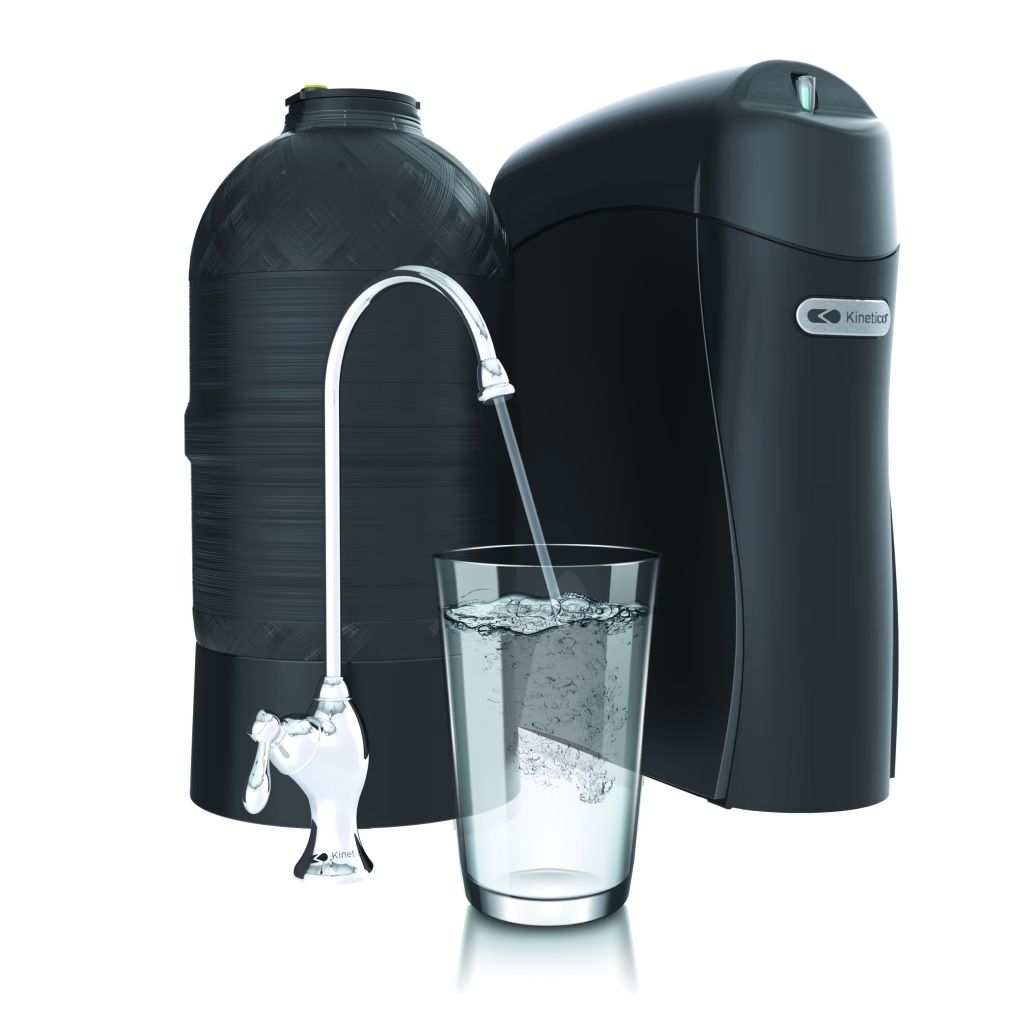
Kinetico® K5 Drinking Water Station®
- Arsenic: 99.3% elimination;
- Lead: 98.1% elimination
- Copper: 98.7% elimination
- Removes PFAS/PFOA
- Protection against a wide variety of contaminants
- FlexFiltration, different cartridge options available
- Patented QuickFlo® Technology, delivers a strong flow of water and produces more water in less time
- High Daily Production
- Quick Disconnect Sanitary Filter Cartridges
- Patented, Exclusive EverClean® Rinse, for high quality water and increased membrane life
- PureMometer® Filter Life Indicator
- Automatic System Shutdown
- Patented MACguard® Filter, prevents filter overuse
- Exclusive Designer Lead-Free Faucet, in a variety of finishes
- Platinum 10 Year Warranty
- Made in the USA
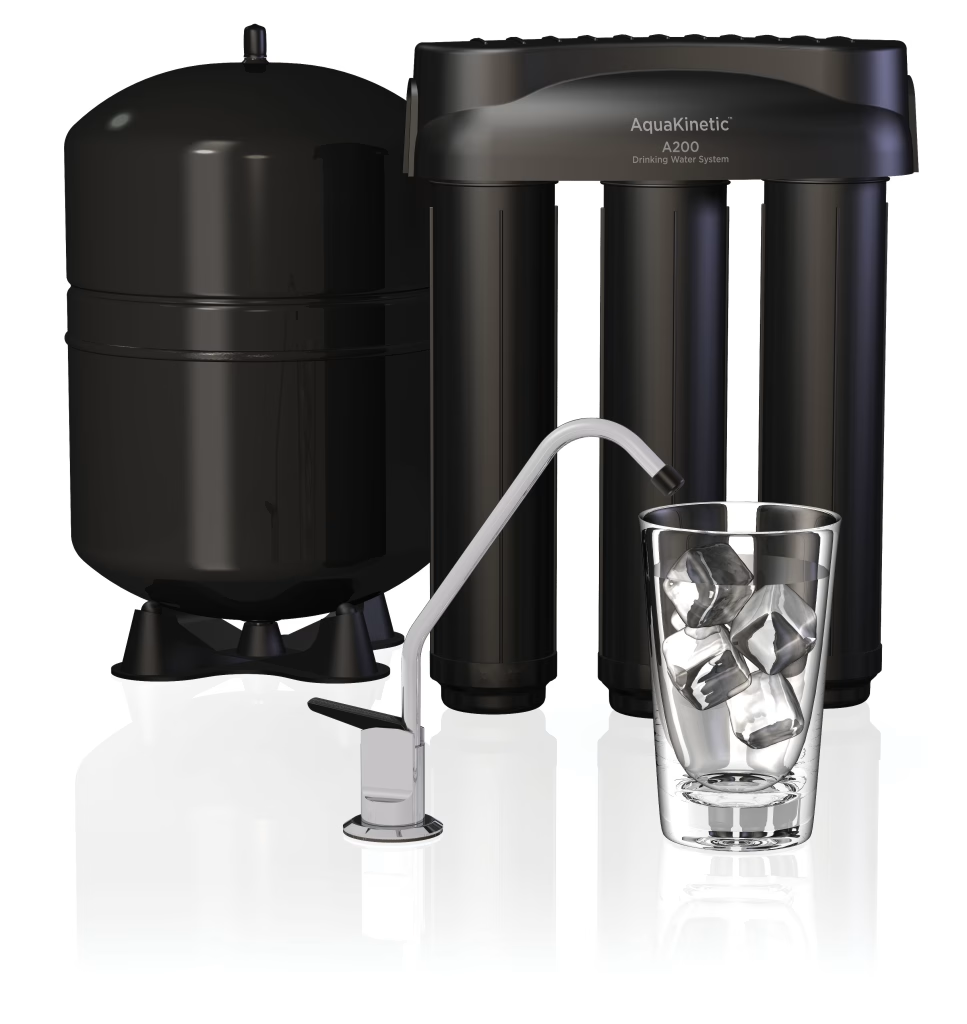
AquaKinetic® A200 Drinking Water System
- Lead: 98.1% elimination
- Copper: 98.7% elimination
- Total Dissolved Solids: 92.4% elimination
- Clean, Refreshing, Filtered Water
- Small and Convenient System – for under sink or in basement
- Quick-Disconnect Filter Cartridges
- High-Performance Reverse Osmosis Membrane
- Quality Construction
- 5 Year Warranty
- Made in the USA
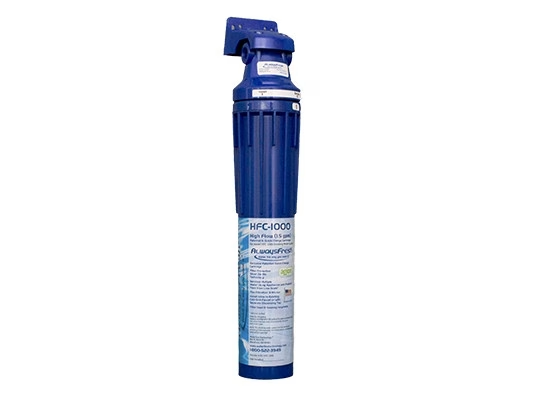
AlwaysFresh HFC-1000
- Built-In 5 micron pre-filter
- Fine filtration down to 0.5 micron (1/50,000 of an inch)
- Adsorptive Media: 500,000 square meters of surface area
Frequently Asked Questions
Water softeners improve the water we bathe in and clean with throughout the home. Softeners are not purifiers and will not reduce a wide range of potential contaminants. Many consumers want to purify their water for drinking, cooking, and ice cubes. Our drinking water systems provide high quality, chemical-free water right at the faucet.
What’s more important to you, the water that goes “on you” or the water that goes “in you?” Most people would answer that the water they consume is more important. That’s why most people that choose to purchase water treatment equipment further refine their drinking water with a separate system.
A water conditioner is typically placed at the point where the water enters the home so it can soften (remove dissolved hardness minerals from) all the water distributed throughout the house. That’s how a water conditioner protects your water heater, water-using appliances, plumbing, sinks, bathtubs, faucets, and other things.
A drinking water system normally services a special faucet at the kitchen sink and further treats (reduces a large number of dissolved solids in) only the water you use for drinking and food preparation. It would be a waste to refine all of the water used in the home to drinking water quality. Treating drinking water at the point of use reduces the cost of the system.
Combination systems that address both kinds of water treatment needs are available. They typically offer the two systems in one complete, compact package.
Studies have found that minerals in your drinking water essentially make no contribution to your health and may even be present in forms your body can’t absorb. Unfortunately, the myth that drinking water with minerals is healthy is perpetuated by companies that promote “mineral water”. In fact, the Water Quality Association, the trade association of the water treatment industry, prohibits health claims in any of its members’ literature and advertising.
The Kinetico K5 Drinking Water Station is customizable to your home’s specific filtration needs and can actually add minerals back to your water to restore alkalinity.
For more information about the water you drink, contact your local water authority. Each year they are required to produce a report on what’s in the water in your area.
Drinking water generally contracts lead from plumbing that has been connected with lead solder (outlawed in 1986) or from outdated water distribution lines. There are a number of things you can do to reduce the risk of lead in your drinking water.
Some sources suggest running your tap water for a couple of minutes before filling a glass to flush any accumulated lead from the water line (lead dissolves into standing water over time). This isn’t a foolproof solution, however, since there is no way of knowing whether all of the lead has been removed and since lead can still dissolve into running water.
Never use hot tap water to prepare drinks or meals. Hot water attracts more lead than cold water does. If you need hot water, heat cold tap water on the stove or in a microwave.
In their informational brochure “Living Lead Free,” the American Water Works Association recommends having your water tested for lead to find out whether you should take action. Your local Kinetico water expert can have your water analyzed by a laboratory and help you decipher the results.
Use a carbon drinking water filter or reverse osmosis system that has been certified to protect your drinking water from lead. Check that the manufacturer’s claims have been verified by the Water Quality Association or NSF International; not all systems are certified for lead reduction.
Bottled water is an acceptable alternative if you would like better tasting water for drinking and cooking, but it can be expensive, a hassle to carry from the store, can contain harmful BPA chemicals and other bacteria, not to mention all those plastic bottles in our landfills.
It’s generally much less expensive in the long run to use a home drinking water system. Drinking water systems are convenient and provide you with high quality, environmentally-friendly water in your own home when you want it, at prices per gallon that are considerably lower than bottled water.
Check to see that the system you choose is certified to protect you from a wide variety of contaminants and that the manufacturer’s claims have been verified by the Water Quality Association or NSF International.
Your K5 has an indicator at the top of the unit that will slowly drop with use. This gives you an early warning that it’s time to order new filters. Once the filters have maxed out their usable lifespan, you’ll notice a loss of pressure as your K5 slows to a trickle and shuts down. We suggest purchasing shelf-stable replacement filters once the system indicator is below the halfway point–that way, you have them on hand and don’t have to scramble to find filters while guests are arriving for a dinner party. You can even change the filters yourself with our easy-to-follow Kinetico RO Filter Change Instructions.
- Turn off the main valve to the drinking system and the valve to the tank. If unsure, it’s best to turn off any valves connected to the system by following the tubing. Now depressurize your system of all air and water by opening the RO faucet. There should be no water running out of the tap/faucet.
- Remove the old filter. This will be yellow or purple.
- Fill the new filter with water. This will replace the pre-filter (yellow or purple filter) that was just removed
- Remove and replace post-filter (orange or blue filter). This will be under the blue indicator/meter.
*Remove and replace any K5 auxiliary filters, if applicable. DO NOT REMOVE the membrane filter (green sticker), usually located in the middle. - Slowly turn the water supply back on to the drinking system and tank.
- Turn on water and let it run until the tank is empty.
- Allow unit to refill with water for at least 2 hours before using.
Explore the tap water database to learn more about what pollutants have been found in your local tap water, just search by zip code: Visit ewg.org/tapwater/
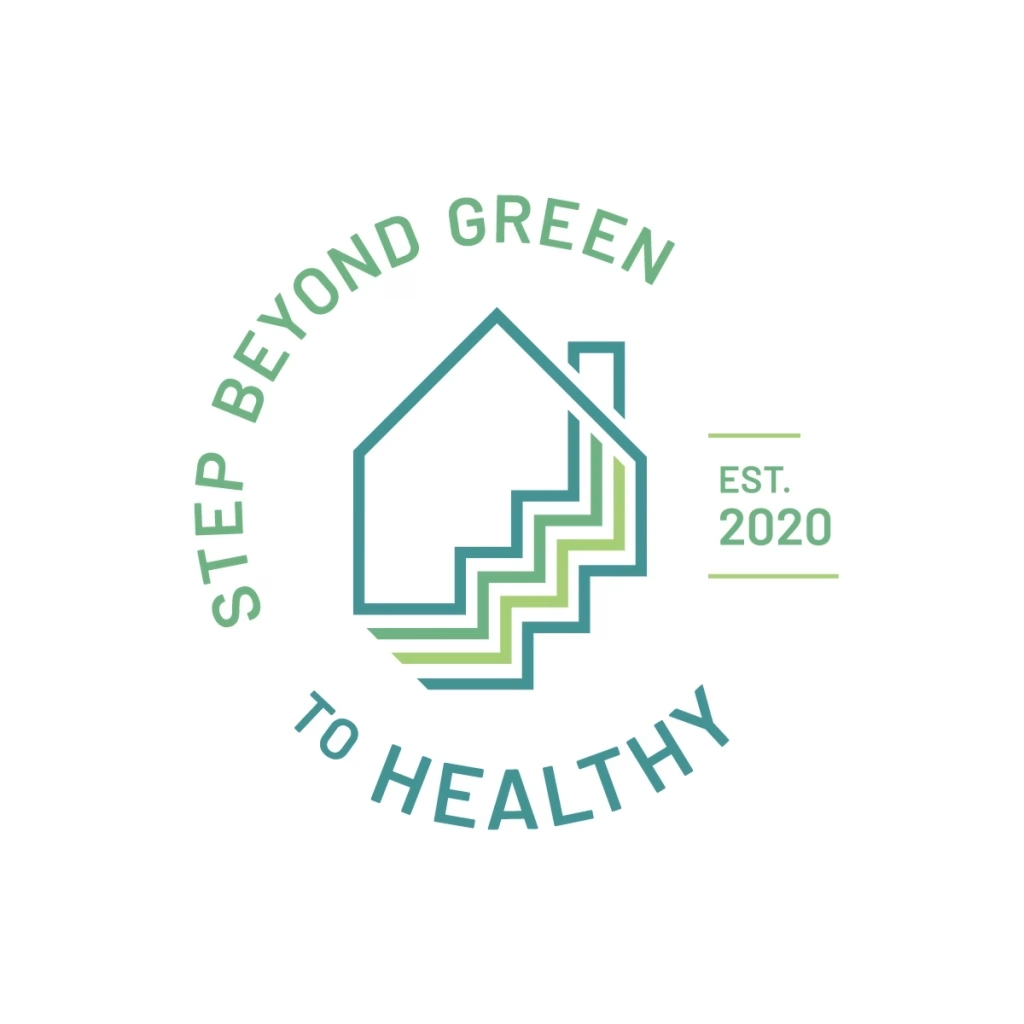
Our Healthy Approach to Water
Contact Us
Get in touch for expert advice and support!
Get a Free Water Test
Schedule a free consultation in your home or office with our team of experts today!
